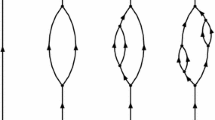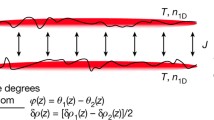Abstract
As a first step in a theoretical study of the properties of liquid4He we have calculated the binding energy from two-body correlations in the system. Using an effective interaction or reaction matrix obtained by a modified Brueckner theory, low-temperature properties such as the binding energy, the elementary excitation energy spectrum, and the velocity of first (ordinary) sound are calculated or estimated. For simplicity we use the approximation of a reference energy spectrum with a quadratic momentum dependence for the input single-particle energy spectrum, which in principle should be fitted to self-consistent single-particle energies. The intermediate-state potential energies are, however, chosen to be equal to zero. Hence, the three-body energy contribution and also higher order energy contributions must be estimated by separate calculations. A self-consistent solution is obtained through the depletion of the zero-momentum state, which is also calculated. The calculations are done for two different two-body potentials, an Yntema-Schneider potential given by Brueckner and Gammel, and a Frost-Musulin potential given by Bruch and McGee. The theoretical results are −3.1 to −4.0°K for the binding energy, 39–44% for the depletion, and 176–217 m/sec for the sound velocity. The corresponding experimental results are −7°K, 83%, and 238.3 m/sec, respectively, i.e., the difference is generally within a factor of two. The agreement with experimental results is reasonably good (or bad), especially since three-body and higher order cluster terms are not included in this first approximation.
Similar content being viewed by others
References
L. Landau,J. Phys. USSR 5, 7 (1941);8, 1 (1944);11, 91 (1947).
L. Landau,Phys. Rev. 60, 356 (1941);75, 884 (1949).
M. Cohen and R. P. Feynman,Phys. Rev. 107, 13 (1957).
R. Jastrow,Phys. Rev. 98, 1479 (1955).
R. Abe,Progr. Theoret. Phys. 19, 57 (1958);19, 407 (1958).
F. Y. Wu and E. Feenberg,Phys. Rev. 122, 739 (1961).
W. L. McMillan,Phys. Rev. 138, A442 (1965).
W. E. Massey,Phys. Rev. 151, 153 (1966);157, 190 (1967).
D. Schiff and L. Verlet,Phys. Rev. 160, 208 (1967).
W. E. Massey and C.-W. Woo,Phys. Rev. 164, 256 (1967).
O. Penrose and L. Onsager,Phys. Rev. 104, 576 (1956).
S. T. Beliaev,Soviet Phys.—JETP 7, 289 (1958);7, 299 (1958).
N. M. Hugenholtz and D. Pines,Phys. Rev. 116, 489 (1959).
A. J. Kromminga and M. Bolsterli,Phys. Rev. 128, 2887 (1962).
M. Girardeau and R. Arnowitt,Phys. Rev. 113, 755 (1959).
G. Wentzel,Phys. Rev. 120, 1572 (1960).
M. Luban,Phys. Rev. 128, 965 (1962).
G. V. Brown and M. H. Coopersmith,Phys. Rev. 178, 327 (1969).
N. N. Bogoliubov,J. Phys. USSR 11, 23 (1947).
T. D. Lee, K. Huang, and C. N. Yang,Phys. Rev. 106, 1135 (1957).
T. D. Lee and C. N. Yang,Phys. Rev. 112, 1419 (1958);113, 1406 (1959).
K. A. Brueckner and K. Sawada,Phys. Rev. 106, 1117 (1957);106, 1128 (1957).
W. E. Parry and D. Ter Haar,Ann. Phys. 19, 496 (1962).
R. Abe,Progr. Theoret. Phys. 20, 785 (1958).
V. Singh,Phys. Rev. 116, 507 (1959).
K. Sawada,Phys. Rev. 116, 1344 (1959);119, 2090 (1960).
K. Sawada and L. W. Bruch,Phys. Rev. 131, 1379 (1963).
L. W. Bruch and K. Sawada,Phys. Rev. 132, 499 (1963).
L. Liu and K. W. Wong,Phys. Rev. 132, 1349 (1963).
L. Liu, L. S. Liu, and K. W. Wong,Phys. Rev. 135, A1166 (1964).
E. Byckling,Phys. Rev. 145, 71 (1966).
D. F. Goble and L. E. H. Trainor,Can. J. Phys. 46, 839 (1968).
P. C. Hohenberg and P. M. Platzman,Phys. Rev. 152, 198 (1966).
R. A. Cowley and D. B. Woods,Phys. Rev. Letters 21, 787 (1968).
B. H. Brandow,Phys. Rev. Letters 22, 173 (1969);Ann. Phys. (to be published).
B. H. Brandow,Phys. Rev. 152, 863 (1966).
J. Goldstone,Proc. Phys. Soc. (London)A239, 267 (1957).
J. W. Clark and P. Westhaus,Phys. Rev. 141, 833 (1966).
H. A. Bethe, B. H. Brandow, and A. G. Petschek,Phys. Rev. 129, 225 (1963).
K. A. Brueckner and J. L. Gammel,Phys. Rev. 109, 1040 (1958).
L. M. Bruch and I. J. McGee,J. Chem. Phys. 46, 2959 (1967);52, 5884 (1970).
D. G. Henshaw,Phys. Rev. 119, 9 (1960);119, 14 (1960).
O. Penrose,Phys. Letters 11, 224 (1964).
W. E. Parry and C. R. Rathbone,Proc. Phys. Soc. (London)91, 273 (1967).
W. P. Francis, G. V. Chester, and L. Reatlo,Phys. Rev. A1, 86 (1970).
A. Miller, D. Pines, and P. Nozières,Phys. Rev. 127, 1452 (1962).
D. H. Kobe,Ann. Phys. 47, 15 (1968).
O. K. Harling,Phys. Rev. Letters 24, 1046 (1970).
R. D. Puff and J. S. Tenn,Phys. Rev. A1, 125 (1970).
C. E. Campbell and E. Feenberg,Phys. Rev. 188, 396 (1969).
R. D. Murphy and R. O. Watts,J. Low. Temp. Phys. 2, 507 (1970).
P. R. Zilsel,Phys. Rev. Letters 15, 476 (1965).
H.-K. Sim and C.-W. Woo,Phys. Rev. 185, 401 (1969).
K. Sawada and R. Vasudevan,Phys. Rev. 124, 300 (1961).
R. Abe,Progr. Theoret. Phys. 19, 1 (1958);19, 699 (1958);19, 713 (1958).
W. Brenig and W. E. Parry,Z. Physik 175, 40 (1963).
J. G. Valatin and D. Butler,Nuovo Cimento 10, 37 (1958).
H. W. Jackson and E. Feenberg,Ann. Phys. 15, 266 (1961);Rev. Mod. Phys. 34, 686 (1962).
W. M. Whitney and C. E. Chase,Phys. Rev. 158, 200 (1967).
D. G. Henshaw and A. D. B. Woods,Phys. Rev. 121, 1266 (1961).
Author information
Authors and Affiliations
Rights and permissions
About this article
Cite this article
Østgaard, E. Liquid4He. I. Binding energy and excitation energy spectrum from two-body correlations. J Low Temp Phys 4, 239–262 (1971). https://doi.org/10.1007/BF00629712
Received:
Issue Date:
DOI: https://doi.org/10.1007/BF00629712




